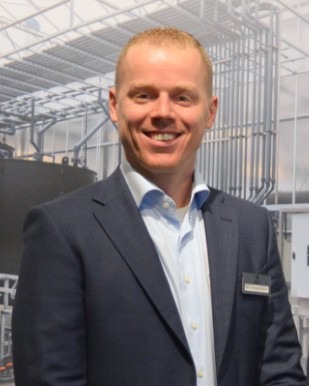 More and more growers are looking at their water supply. Good water can no longer be taken for granted. "The same applies to water as to CO2. That is really underestimated. Sometimes people still think about it too casually," notes Ben Hoogendoorn of Horticoop Technical Services. Although he can see from the interest in underground water storage, among other things, things are changing. "For certain areas, it is an interesting option."
More and more growers are looking at their water supply. Good water can no longer be taken for granted. "The same applies to water as to CO2. That is really underestimated. Sometimes people still think about it too casually," notes Ben Hoogendoorn of Horticoop Technical Services. Although he can see from the interest in underground water storage, among other things, things are changing. "For certain areas, it is an interesting option."
With underground water storage, water is infiltrated into underground aquifers with the aim of being able to use it during dry periods. Even in the notorious wet Netherlands, those dry periods are becoming more frequent. Many a grower will be familiar with the image of a slowly emptying water basin while plants need water daily.

Reverse osmosis
Growers have been making good use of rainwater for years. They collect it, in basins or silos, sometimes with reverse osmosis as an intermediate step to bring the water to the desired quality. Reverse osmosis is also an intermediate step used to make water from other sources suitable for use as irrigation water.
The only question is, how long will reverse osmosis be allowed? Ben also quotes. "Reverse osmosis remains a talking point. You have been hearing for years that it is coming to an end, but it is still not banned. It is a grey area, though." However, as long as there is no alternative, it should not be banned as far as the Horticoop Technical Services sales manager is concerned.
Meanwhile, a grower can use underground water storage just fine, and, according to him, it is now the only alternative to osmosis. With the water challenges at hand, the engineering company sees opportunities for underground water storage. "Like reverse osmosis, you use standing bubbles underground. You can put water in there in the winter if enough rain falls. In summer, you can take that water out again." If the wells are far enough apart, growers can combine reverse osmosis and underground water storage.

EC
You can't store water in standing underground bubbles everywhere. "In Tinte, we did some work, but there the EC turned out to be too high. The soil was too salty. Of every 10 liters of good water you injected into the soil, you only got back one good one. The water salts very quickly, so it is not profitable."
The type of soil also matters. With sandy soil, even the layman understands that water does not 'stick' well in the soil. In Limburg and parts of North Brabant, underground water storage is therefore not really an option. Around Steenbergen and Dinteloord, on the other hand, it does happen, and in other regions, it goes well.
These are regions with good standing water layers with also low EC, in which underground water storage is good. The same applies to the region around Aalsmeer. "There you get 7 or 8 liters out, for example, for every 10 liters you put in. Then it becomes interesting."
They are also working on projects in Westland, Ben knows. He points out that a higher EC in the soil does not have to be an immediate problem. "Do you dare to grow with a slightly higher EC, is then the question. If the bubble you store water in is not big enough, you get mixing, and the EC can rise. Then it's a matter of watching carefully when you want to infiltrate water and take it out again."

Sources
To get good wells in the soil, wells have to be drilled. Horticoop Technical Services does not do that itself. "A specialist in drilling wells maps what the soil looks like and, for example, also looks at where other wells are in the soil. This can be done at different depths, say 30, 50, or 100 meters. That is determined in the field."
Based on how much water a grower wants to store in the soil, the number of wells is determined. Sources should not be too close together. "It varies here how many cubic meters of water a customer wants to infiltrate and extract. Playing with different heights and thus storing water in different layers is possible," Ben knows.
Horticoop Technical Services itself has a lot of expertise in underground water storage. With the acquisition last year, of people from Codema with specific knowledge, even more expertise was added. "We have the materials, the knowledge and can also engineer everything," he says.

Clean and cool water
Above ground, a grower typically needs about 10 square meters of space to install underground water storage. A grower needs a filter system and a pumping unit. "The filter system is needed to filter the basin water before you infiltrate it. The pump is needed to bring it back up afterward. By pumping in clean water, the well stays well clean, and you also get clean water back."
Integration into an existing water system is easy. "After pumping the water up, it can go back into the basin after filtration, for example. After that, the grower can disinfect the water if necessary, as is done with water from other sources. Due to the frequent filtering, the water from underground water storage is also perfect for use in drip and mist systems."
Other advantages of underground water storage are, of course, that it allows growers to make smart use of the available space because, unlike a basin when building, (hardly any) extra soil is needed above ground and that the water stays cool well and free of algae.
"Above ground, it is often difficult for growers to find any more space, but customer-specific, we always find a free corner for the piece of above-ground installation," Ben knows from experience. "Once the wells are drilled, things can move quickly on site. Usually, the unit can be finished in about a week. Preparation is still the most work. It is best when a grower can start storing water right at the start of the rainy season. Those who start now are still in good time."
For more information:
Ben Hoogendoorn 
Horticoop Technical Services
[email protected]
www.hcts.tech










